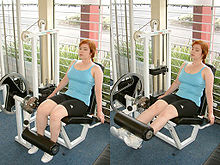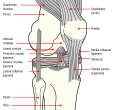Quadriceps
| Quadriceps femoris muscle | |
|---|---|
 Quadriceps femoris, with different muscles in different colors.
| |
| Details | |
| Origin | Combined rectus femoris and vastus muscles |
| Insertion | Tibial tuberosity |
| Artery | Femoral artery |
| Nerve | Femoral nerve |
| Actions | Knee extension; hip flexion (rectus femoris only) |
| Identifiers | |
| Latin | musculus quadriceps femoris |
| MeSH | D052097 |
| TA98 | A04.7.02.017 |
| TA2 | 2613 |
| FMA | 22428 |
| Anatomical terms of muscle | |
The quadriceps femoris muscle (/ˈkwɒdrɪsɛps ˈfɛmərɪs/, also called the quadriceps extensor, quadriceps or quads) is a large muscle group that includes the four prevailing muscles on the front of the thigh. It is the sole extensor muscle of the knee, forming a large fleshy mass which covers the front and sides of the femur. The name derives from Latin four-headed muscle of the femur.
Structure
[edit]
Parts
[edit]The quadriceps femoris muscle is subdivided into four separate muscles (the 'heads'),[1][2] with the first superficial to the other three over the femur (from the trochanters to the condyles):
- The rectus femoris muscle occupies the middle of the thigh, covering most of the other three quadriceps muscles.[1] It originates on the ilium. It is named for its straight course.
- The vastus lateralis muscle is on the lateral side of the femur (i.e. on the outer side of the thigh).[1]
- The vastus medialis muscle is on the medial side of the femur (i.e. on the inner part thigh).[1]
- The vastus intermedius muscle lies between vastus lateralis and vastus medialis on the front of the femur (i.e. on the top or front of the thigh), but deep to the rectus femoris muscle. Typically, it cannot be seen without dissection of the rectus femoris.[1]
Attachments
[edit]The rectus femoris arises from the anterior inferior iliac spine and from the superior edge of the acetabulum.[1] It is thus a biarticular muscle. The other parts of the quadriceps arise from the surface of the femur. All four parts of the quadriceps muscle ultimately insert into the tuberosity of the tibia via the patella, where the quadriceps tendon becomes the patellar tendon.[1]
Other muscles
[edit]There is a small fifth muscle of the quadriceps complex—the articularis genus muscle—that is not often included.
In addition, cadaver studies have confirmed the presence of a sixth muscle, the tensor vastus intermedius.[3] While this muscle has a variable presentation, it consistently originates at the proximal femur, runs between the vastus lateralis and vastus intermedius muscles, and inserts distally at the medial aspect of the patellar base.[3] Historically considered a part of the vastus lateralis muscle, the tensor vastus intermedius muscle is innervated by an independent branch of the femoral nerve and its tendinous belly can be separated from the vasti lateralis and intermedius muscles in most cases.[3]
Innervation
[edit]The quadriceps femoris is innervated by the femoral nerve, which originates from L2, L3, L4.[1][4]
Function
[edit]All four quadriceps are powerful extensors of the knee joint.[1][4] They are crucial in walking, running, jumping and squatting. Because the rectus femoris attaches to the ilium, it is also a flexor of the hip.[1][4] This action is also crucial to walking or running, as it swings the leg forward into the ensuing step. The quadriceps, specifically the vastus medialis, play the important role of stabilizing the patella and the knee joint during gait.[5]
Clinical significance
[edit]The quadriceps femoris muscle is a target for manual therapy and physical therapy from repetitive strain injuries, such as from skiing.[6]
The quadriceps femoris muscle is the most common site of myositis ossificans.[7]
Society and culture
[edit]Training
[edit]
In strength training, the quadriceps are trained by several leg exercises including the squat, leg press, and leg extension.
Etymology
[edit]The proper Latin plural form of the adjective quadriceps would be quadricipites. In modern English usage, quadriceps is used in both the singular and plural form. The singular form quadricep, produced by back-formation, is frequently used.
Additional images
[edit]-
The quadriceps tendon connects to the top part of the kneecap (patella)
-
Cross-section through the middle of the thigh
-
The quadriceps forms the bulk of front part of the thigh
See also
[edit]References
[edit]- ^ a b c d e f g h i j Bakkum, Barclay W.; Cramer, Gregory D. (2014-01-01), Cramer, Gregory D.; Darby, Susan A. (eds.), "Chapter 4 - Muscles That Influence the Spine", Clinical Anatomy of the Spine, Spinal Cord, and Ans (Third Edition), Saint Louis: Mosby, pp. 98–134, doi:10.1016/b978-0-323-07954-9.00004-9, ISBN 978-0-323-07954-9, retrieved 2020-12-23
- ^ Chaitow, Leon; DeLany, Judith (2011-01-01), Chaitow, Leon; DeLany, Judith (eds.), "Chapter 13 - The knee", Clinical Application of Neuromuscular Techniques, Volume 2 (Second Edition), Oxford: Churchill Livingstone, pp. 447–501, doi:10.1016/b978-0-443-06815-7.00013-9, ISBN 978-0-443-06815-7, retrieved 2020-12-23
- ^ a b c Grob, K; Ackland, T; Kuster, MS; Manestar, M; Filgueira, L (6 January 2016). "A newly discovered muscle: The tensor of the vastus intermedius" (PDF). Clinical Anatomy. 29 (2): 256–263. doi:10.1002/ca.22680. PMID 26732825. S2CID 38157592.
- ^ a b c Felten, David L.; O'Banion, M. Kerry; Maida, Mary Summo (2016-01-01), Felten, David L.; O'Banion, M. Kerry; Maida, Mary Summo (eds.), "9 - Peripheral Nervous System", Netter's Atlas of Neuroscience (Third Edition), Philadelphia: Elsevier, pp. 153–231, doi:10.1016/b978-0-323-26511-9.00009-6, ISBN 978-0-323-26511-9, retrieved 2020-12-23
- ^ Therapeutic Exercises, Carolyn Kisner & Lynn A. Colby, 5th ed. (2002) 692-93.
- ^ Jelvéus, Anders (2011-01-01), Jelvéus, Anders (ed.), "5 - Sports massage applications for different sports", Integrated Sports Massage Therapy, Edinburgh: Churchill Livingstone, pp. 61–73, doi:10.1016/b978-0-443-10126-7.00005-8, ISBN 978-0-443-10126-7, retrieved 2020-12-23
- ^ Landes, Caren J. (2011-01-01), Allan, Paul L.; Baxter, Grant M.; Weston, Michael J. (eds.), "CHAPTER 73 - Paediatric musculoskeletal imaging", Clinical Ultrasound (Third Edition), Edinburgh: Churchill Livingstone, pp. 1497–1513, doi:10.1016/b978-0-7020-3131-1.00073-0, ISBN 978-0-7020-3131-1, retrieved 2020-12-23
External links
[edit]- Quadriceps muscle at the Duke University Health System's Orthopedics program
- "Anatomy diagram: 39960.000-1". Roche Lexicon - illustrated navigator. Elsevier. Archived from the original on 2014-01-01.



